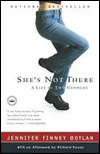 She’s Not There: A Life in Two Genders
She’s Not There: A Life in Two Genders
By Jennifer Finney Boylan
Broadway Books, 2003
She’s Not There is a memoir. I was drawn to it by several things: I love memoirs, it was written by an English professor, and it addresses a difficult, private, timely topic: what it means to be transgendered.
The 18th-century writer Samuel Johnson, my hero, once wrote, “I have often thought that there has rarely passed a life of which a judicious and faithful narrative would not be useful; for not only every man has, in the mighty mass of the world, great numbers in the same condition with himself, to whom his mistakes and miscarriages, escapes and expedients, would be of immediate and apparent use; but there is such a uniformity in the state of man, considered apart from adventitious and separable decorations and disguises, that there is scarce any possibility of good or ill but is common to human kind” (Rambler # 60). Johnson was right. We are held together by our common humanity, and every one of us has something to learn from the story of the life of another person. That’s why memoirs are such an important part of the human story.
But at another level the story of a person, born male, who always felt foreign in the male body, who struggled for years to make peace with the discord between inner identity and biological assignment, is so foreign to the experience of many readers that we might be tempted to dismiss it as unique, eccentric, inapplicable to our own lives.
You won’t have that experience reading this fine book. Jennifer Boylan’s telling of her story is compelling, funny and profound. An English professor at Colby College in Maine, she is close friends with the novelist Richard Russo, and there is a point in this book in which the two writers are lamenting one of the challenges of comic novelists: that their genre requires them to produce prose that seems effortless, despite the fact that extraordinary effort is required to make their prose seem effortless, so that readers tend to dismiss their craft, thinking, “I could have written that.” The prose of this memoir seems effortless. It might be best to call it “transparent”: it reads like a conversation in which Boylan recounts the path that led her from boyhood to college to graduate school to marriage and a family to a breakdown of sorts that convinced her to change genders. It seems honest, insightful, unpretentious and clear-eyed.
The artfulness of this book is perhaps the greatest challenge to reading it. It seems to me that the story it tells is so extraordinarily wrenching for her personally, and the effects of Jennifer Boylan’s decision to change genders so devastating for her friends and family, that you might expect to see some element of that struggle reflected in the prose. But you don’t. The narrative is, as I said above, compelling, and it opens windows from time to time into the sadness, confusion, joy, and other emotions that mark the writer’s journey. But at the end of the day it is artfully smooth. The most poignant moment of the book for me occurs about two-thirds of the way through when the author and his wife (this is before the gender shift) speak about what lies before them. His wife, who is presented with love and gentleness in this narrative, says quite plainly, “Every success you’ve had as a woman is also a loss for me. … All of that success for you just feels like failure to me. … All of the good things that have happened to you… to me, they all just mean one more thing I’ve lost” (p. 217). This is a powerful moment. I wish it had gotten more attention.
If you’re interested in this book, I invite you to read Crossing: A Memoir by the distinguished economist Deirdre N. McCloskey, my friend. She also began life as a man and changed genders. It’s another memoir of the same journey that Jennifer Boylan took, but it is told not by a practiced creative writer but rather by a working economist. The outlines of the story are, in many respects, similar. The experience of reading them is quite different. It was more fun to read Boylan’s book; McCloskey’s seemed more authentic.
 Heat
Heat
By Bill Buford
Vintage Books, 2007
The full title of this book, Heat: An Amateur’s Adventures as Kitchen Slave, Line Cook, Pasta-Maker, and Apprentice to a Dante-Quoting Butcher in Tuscany, gives you a sense of what it’s like as a read. The author, formerly a staff writer and fiction editor at The New Yorker, embarked on a food odyssey that began when the celebrity chef Mario Batali came to dinner at his house and ended with him working as a butcher in a small town in Tuscany. The full title of the book enumerates the stages of this journey, and there is a logic to it: to get ever closer to the intimate connection — in an ideal world — between us and the food we eat. Buford articulates the logic of his journey very well near the end of the book:
For millennia, people have known how to make their food. They have understood animals and what to do with them, have cooked with the season and had a farmer’s knowledge of the way the planet works. They have preserved traditions of preparing food, handed down through generations, and have come to know them as expressions of their families. People don’t have this kind of knowledge today, even though it seems as fundamental as the earth, and, it’s true, those who do have it tend to be professionals — like chefs. But I didn’t want this knowledge in order to be a professional; just to be more human. (p. 313)
The first part of this book, which tells the story of Buford’s experiences cooking in Mario Batali’s restaurant, may remind you of another fun book about cooking, Kitchen Confidential: Adventures in the Culinary Underbelly, by Anthony Bourdain. It depicts the same frantic, desperate, profane kitchen culture that Bourdain depicts. It’s exciting to read, it’s funny, and it makes you want to apply for a job as a line cook just to see if you could do it.
As this book progresses, however, it becomes more than just another chef’s memoirs about being slammed with too many orders and becomes instead a thoughtful meditation on our connection to what we eat. In many ways it ends up at the same place as In Defense of Food: An Eater’s Manifesto by Michael Pollan, but it’s much less polemical and, frankly, Buford isn’t as much of a sorehead as Pollan. Buford argues eloquently for the virtues of “small food,” food made in small quantities, by hand, by cooks who personally select the ingredients, use family recipes, and work from a memory of the tastes they grew up with.
This isn’t a recipe book, but there are some discussions of certain dishes that will send you to the store right away to assemble the ingredients and try for yourself, including how to cook short ribs, how to make ragu, what makes the perfect spaghetti alla vongole, and a whole discussion of gnocchi that is quite amusing.
Heat is just plain fun to read if you like good food, if you’re interested in Italy, or if you think of yourself as a cook. You can enjoy it in bits, like a good meal. I hope you do.
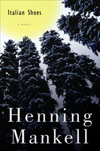 Italian Shoes
Italian Shoes
By Henning Mankell
Translated from the Swedish by Laurie Thompson
The New Press, 2006
Henning Mankell is best known as the author of the Kurt Wallander detective novels, which I have read with pleasure. This is a very different kind of novel. It will challenge you and make you uncomfortable, but it will reward you with a moving narrative about redemption.
The novel is narrated by Fredrik Welin, a surgeon who retired early after he made a horrible mistake in the operating room. Ashamed and guilt-ridden, he has retreated to the island where his grandparents had lived. He is the only inhabitant, except for two pets, a dog and a cat. He receives no telephone calls, neither writes nor receives letters, has neither internet access nor a television. During winter the island is surrounded by ice, which aptly characterizes his inner life as well as his outer life. Each winter morning Welin walks out to the sea, chops a hole in the ice and jumps in the water, just to assure himself that he’s still alive. His only human contact is the postman who stops at his island every other day, whether there’s mail or not.
It gets worse. As a young man, Welin had been in love with a woman named Harriet, whom he cruelly abandoned for reasons that he never fully explains — perhaps because he does not understand, or is not willing to admit, them himself. Here’s another source of guilt.
It’s a miserable life. Welin defends himself from the pain he has caused and the guilt he feels by freezing himself inside or, to use another metaphor in the novel, by closing all the doors to his inner life. Only his care for his animals and his daily ice baths offer any suggestion that he has the capacity or the need to change.
Then one day Harriet, dying of cancer so advanced that she can only move with a walker, appears on the frozen sea at the edge of his island. The postman has dropped her off and gone away. Thus begins Welin’s reawakening and, ultimately, his redemption. Harriet demands that he fulfill a promise he made when they were young to take her to visit a pool in a forest that Welin visited with his father as a boy. That journey leads to a shocking discovery and then to a series of people and events that ultimately dissolve Welin’s inner frost and open his inner doors, but not before he suffers gains and losses, behaves well and badly, and comes to a deeper understanding of himself and his own past.
Welin is not necessarily a person you would want to know, and he is a difficult narrator to warm up to. On the other hand, only sinners need redemption, and he sorely needs it. I said this book would challenge you because it requires the reader to observe the painful journey toward redemption by a flawed narrator surrounded by other flawed people who inhabit a flawed world. But redemption does come.
This is a fine novel about aging, family dynamics, guilt, and self-knowledge. Even in translation it is often lyrical. And it is very powerful. I recommend it.
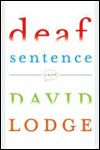 Deaf Sentence
Deaf Sentence
By David Lodge
Viking, 2008
David Lodge is a British novelist and literary critic best known for his very funny satires of academics, especially Changing Places and Small World, two novels I highly recommend. He writes academic novels, but his fictions are more universal than that designation suggests. He is a novelist of manners who happens to set many of his novels in academic settings. You might also call him a novelist of the midlife crisis, since some of his best work portrays protagonists trapped at middle age in jobs, marriages or relationships — or all of the above — that seem to be dead ends. His examination of that dynamic is both piercing and tender.
Deaf Sentence, Lodge’s most recent novel, tells the story of Desmond Bates, a retired professor of linguistics at a university in northern Britain. Desmond is married to a young, energetic, successful woman (a former student). She is still working, a fact that—compared to his retired lifestyle—tends to emphasize their age difference and make him feel somewhat ineffective and pointless. Then there’s Desmond’s father, who is cranky, eccentric, and independent, and is showing signs that he may no longer be able to live independently. But the key fact about Desmond Bates is that he is going deaf, and it’s his deafness that to some extent isolates him from others, emphasizes his age, and undermines his confidence. The novel studies his evolving relationship with his wife, the increasingly paternal role he must play for his father, and portrays the results of his increasing deafness on every aspect of his life.
The Times Literary Supplement claimed of this novel that, “Probably no other work of fiction (and possibly no medical account) has described so successfully the multiplicity of confusions, frustrations and social stratagems deriving from deafness.” I don’t know enough about the literature of deafness to evaluate that claim, but I can report that Lodge portrays Desmond’s deafness with exquisite feeling and insight. Sometimes the deafness is hilarious, sometimes it’s embarrassing and awkward, sometimes it’s sad. It is always interesting and moving.
This is a fine novel that displays keen insight, gentle humor, and generosity of spirit. I recommend it to you.
 A Book of Ages: An Eccentric Miscellany of Great and Offbeat Moments in the Lives of the Famous and Infamous, Ages 1 to 100
A Book of Ages: An Eccentric Miscellany of Great and Offbeat Moments in the Lives of the Famous and Infamous, Ages 1 to 100
By Eric Hanson
Harmony Books, 2008
This is a fun book by a fun Ole. Eric Hanson ’77 has gleaned from a vast array of scholarly and popular sources a bookful of facts about things that happened to famous people at a certain age in their lives. A Book of Ages is, thus, organized chronologically by year: things that happened to famous people when they were one year old, five years old, 50 years old, and so forth, all the way from age one to age 100. (The temptation, of course, is to turn immediately to your own age, but I don’t advise that: it’s discouraging.)
This is an artfully created book. The author first had to find out all these facts, then select the ones that are most meaningful, then order them to best effect, and then express them just so. The result is a book that is at times hilarious, at others poignant, at others brilliantly ironic. It’s probably not a book that you will read in one sitting. More likely, it will rest on the table next to your favorite chair and give you hours of pleasure as you dip into it over time.
Here are some examples of what you will discover in A Book of Ages:
- At age 10, Elvis Presley sang “Old Shep” at a youth talent contest in Tupelo, Mississippi, winning second prize, which was $5 and free admission to all the rides.
- At age 16, Marlon Brando was sent to military school in Faribault, Minnesota, just south of Northfield. (He was expelled for insubordination.)
- At age 18, Woody Allen earned a D in film production at New York University.
- When he was 22, Alexandre Dumas fought a duel during which his pants fell down.
- At age 29, Jesse James tried to rob the bank in Northfield, Minnesota, but townspeople chased him and his gang out of town.
- Martin Luther was 33 when he nailed his list of complaints about the Catholic Church to the door of his church in Wittenberg. Also at age 33 Michaelangelo was hired to paint the ceiling of the Sistine Chapel, Lewis Carroll published Alice in Wonderland, Walter Cronkite joined CBS, Gertrude Stein met Alice B. Toklas, and Groucho Marx painted on a moustache for the first time.
I could go on and on, but perhaps this list gives you an idea of the flavor of the book. For a sense of the puckish writing that makes the book so fun to read, consider an entry like this one: “Novelist and playwright Sherwood Anderson dies of peritonitis and a perforated bowel after swallowing a toothpick from an hors d’oeuvre at a cocktail party. Ironically, the cocktail party is in Colón, Panama.” Or this one: “William F. Buckley retires from The National Review after 50 years at the helm, 2004. Old conservatives are seen wandering glassy-eyed and rudderless on the Upper East Side of Manhattan. Weeping is heard in Greenwich, Conn.”
It’s always wonderful to see Oles flourishing. Eric Hanson has written an entertaining and intriguing book. I recommend it.
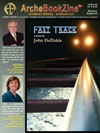 Fast Track
Fast Track
By John DeDakis
ArcheBooks Publishing 2005
I went to high school with the author of Fast Track. He’s now a senior copy editor at CNN, and this is his first novel. It’s fun to reconnect with him through his fiction.
Fast Track is a crime novel. It’s also, and mainly, a coming-of-age novel. The narrator, Lark Chadwick, was raised by her aunt because her parents were killed in a car-train crash when she was an infant. The novel opens with Lark coming home late one evening after work (she dropped out of college after three years and is working in a restaurant) to find her aunt dead of carbon monoxide poisoning, an apparent suicide. Bereft of all family, the 25-year-old Lark embarks on a journey of self-discovery by returning to the nearby small town where she was born to try to find out more about her parents. The more she finds out, the more suspicious the accident that killed her parents becomes, and that, in turn, casts doubt on her aunt’s death. Her self-discovery becomes, simultaneously, an investigation that yields surprising and disturbing results. It also leads Lark better to understand who she is, to embrace a vocation, and to create a new family.
There is an important story about faith embedded in this novel. Lark’s aunt was being counseled by an Episcopal priest, whose ministry to her and Lark leads to a revolt in his parish and teaches Lark an important lesson about forgiveness.
This is also a novel about writing. The vocation Lark discovers for herself is journalism, and it’s an investigative piece that she writes on her parents’ accident that solves the crime and brings the novel to its crisis. Mentored by the distinguished, but curmudgeonly, editor at her hometown newspaper, she learns important lessons about the techniques of journalism and about the ethics of reporting.
This is a tightly-plotted and well-written novel. You should read it.
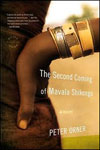 The Second Coming of Mavala Shikongo
The Second Coming of Mavala Shikongo
By Peter Orner
Little, Brown and Company, 2006
St. Olaf Regent Martha Nelson, who knows the author, gave me a copy of this wonderful historical novel about Namibia. Namibia only became independent in 1990, but of course its history stretches back much further than that, to colonization by South Africa and, before that, by Germany. These colonial periods, and the wars of liberation that led to Namibian independence, are always running in the background of this novel, but fundamentally it is about something else.
The principal narrator is an American, Larry Kaplanski from Cincinnati, who is teaching as a volunteer at a boy’s school near Goas in north-central Namibia. The narrative is unconventional, comprised of a series of vignettes, some of them as short as a paragraph and others as long as several pages. These vignettes — which contain snatches of conversation between the teachers at the school, who talk through the paper-thin walls that separate their rooms in the Singles Quarters — tell brief stories of events at the school, paint sketches of other characters in the novel, and so on. So be prepared for a narrative that is connected more often by intuition or association than by chronology and held together more by tone than by the more familiar conventions of plot.
Mavala Shikongo is a young woman who comes to teach at the school. A veteran of the wars of independence, an unwed mother, and the source of erotic fantasies by all the male teachers, she and Kaplansk — an African woman and a white man — begin an affair, carried out on the graves of Boer settlers during siesta.
What is this book about? The effects of war on innocents; frustrated personal and national ambition; love; sex; brutality; coming of age. It is also very funny.
Most of all, what draws you to this novel is its tone, which manages to be both clear-eyed in its recognition of faults and failings and capacious in its ability to forgive. Its power of empathy draws you in and binds you to the lives and thoughts of the characters. It’s a fine novel, and I recommend it enthusiastically.
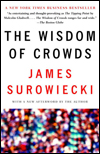 The Wisdom of Crowds
The Wisdom of Crowds
By James Surowiecki
Anchor Books, 2005
Over the past year I have been reading a series of books on the general subject of how we make decisions, toward a goal of creating a conceptual framework to help me, and others, make the best decisions for St. Olaf College. The Wisdom of Crowds was recommended to me by the distinguished environmentalist Susan Seacrest ’75, our 2008 commencement speaker.
Fundamentally, this book argues that “under the right circumstances, groups are remarkably intelligent and are often smarter than the smartest people in them” (p. xiii). Individuals, Surowiecki, argues, are not necessarily “perfectly designed decision makers” (p. xiv). We lack the ability to make “sophisticated cost-benefit calculations,” we let “emotion affect our judgment,” and we generally operate with less information than we need. But the imperfect judgments of imperfect decision makers, when “aggregated in the right way,” are “often excellent” (p. xiv). Surowiecki explains this nicely: if 100 people run a 100-meter race and you average their times, that number will be slower than the fastest runners. But if 100 people answer a question, the average answer will “often be at least as good as the answer of the smartest member” (p. 11).
What conditions are required to tap into the decision-making ability of a group? “Groups generally need rules to maintain order and coherence”; “Groups benefit from talking to and learning from each other”; “Diversity and independence are important because the best collective decisions are the product of disagreement and contest, not consensus or compromise;” “The best way for a group to be smart is for each person in it to think and act as independently as possible” (pp. xix-xx).
Surowiecki describes a multitude of instances where a group made measurably better decisions than any of the individuals in the group, from judging the weight of an ox at a country fair (p. xi) to estimating where a missing submarine might have ended up on the ocean floor (p. xx) to fingering the responsible party in the 1986 Challenger tragedy (pp. 7-10) to predicting the winner of the Iowa presidential primary (pp. 17-22). Some of these groups consist of random fairgoers, some of engineers and military personnel, some of stockholders, some of political junkies.
For me one of the most important insights of this book is the requirement that in order to tap into the power of collective decision-making, the group — whatever its size — must be cognitively diverse. In other words, it must be comprised of individuals with different points of view, different experiences, and different solutions to the problem at hand. Diversity is so important because “it actually adds perspectives that would otherwise be absent and because it takes away, or at least weakens, some of the destructive characteristics of group decision-making” (p. 29). Diversity is more important in a small group or in an organization such as a Board of Directors than in large one, like the stock market, that is almost by definition heterogeneous. Citing research done at the University of Michigan, Surowiecki argues that sheer intelligence alone is not enough to guarantee the best decision-making in a group “because intelligence alone cannot guarantee you different perspectives on a problem” (p. 30). As this book moves from its conceptual argument to the series of case studies that marks its latter half, it returns over and over again to the necessity of cognitive diversity to effective decision-making.
The Wisdom of Crowds is a fundamentally democratic book. It argues for bottom-up, rather than top-down, decision-making. It argues for the free and complete communication of information, and it argues against the cult of the expert. For example, in the context of corporations the book argues that “The more power you give a single individual [i.e., the CEO] in the face of complexity and uncertainty, the more likely it is that bad decisions will get made. As a result, there are good reasons for companies to try to think past hierarchy as a solution to cognition problems” (p. 221).
It’s easy to make fun of the decision-making process in place at most colleges and universities. I’ve done it myself. Certainly anyone who has ever sat through a faculty meeting or seen a committee take a year to come up with a recommendation has reason to lament the inefficiencies inherent in the system. On the other hand, The Wisdom of Crowds suggests that the deliberative process in place at an institution like St. Olaf, though cumbersome at times, conforms rather well to the best practices for tapping into the collective wisdom of the crowd. Where this book suggests that the college needs to exercise vigilance is in the need for cognitive diversity among its decision makers. One of St. Olaf’s great strengths is its strong institutional identity, born of its history and nurtured over time. As with individuals so it is with institutions: often our greatest weaknesses are the flip side of our greatest strengths, and in seeking to be faithful to our history and to preserve our identity we need to guard against closing off the kind of diversity of opinion and experience that might limit us over time.
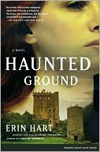 Haunted Ground
Haunted Ground
By Erin Hart
Scribner, 2003
Oles go on from our college to do many good things, including writing fine novels like this one by Erin Hart ’80. Greg Kneser, our esteemed dean of students at St. Olaf, shared this book with me, and I recommend it highly to you.
Haunted Ground begins with a grisly discovery. A farmer digging peat in a bog in Ireland unearths the severed head of a young woman. Apparently, bogs have preservative powers, so the head could be hundreds of years old. The National Museum in Ireland has jurisdiction over such bog finds, and they dispatch Cormac Maguire, an archeologist at University College, Dublin, and Nora Gavin, a lecturer in anatomy at Trinity College Medical School, to investigate. To complicate matters, the bog in which the head was discovered sits at the nexus of a whole set of tensions, conflicts, and complications among neighboring residents, including an angry farmer with a complex family dynamic, a widower whose wife and son recently disappeared and who is a suspect in their disappearance, Detective Garrett Devaney who is not supposed to be investigating the disappearance of the wife and son but does so anyway, and more than a little sexual tension between Cormac and Nora.
If it sounds to you as though there’s a lot going on in this novel, you’re right: there is. But Hart interweaves the narrative of the investigation into the severed head, the investigation into the disappearance of the wife and son, the issues of the angry farmer and his family, and the relationship between Nora and Cormac into one coherent story. The narratives become more closely connected as the novel progresses, until by the end pulling on one thread unravels them all. This is a novel about parents and their children, about husbands and wives, about lovers, about anger, and about forgiveness.
If you are interested in Ireland and things Irish you will love this book for its powerful evocation of Irish musical traditions, its depiction of Irish landscapes, its portraits of the Irish, and its careful attention to Irish history. If you love rich and evocative prose, you will admire this novel’s bold eloquence. And if you love a narrative about how a crime gets solved, you will take pleasure in Detective Garrett Devaney’s unraveling of a modern crime and Cormac and Nora’s unraveling of an ancient one.
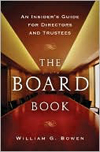 The Board Book: An Insider’s Guide for Directors and Trustees
The Board Book: An Insider’s Guide for Directors and Trustees
By William G. Bowen
W. W. Norton & Company, 2008
William G. Bowen, president emeritus of Princeton University and president emeritus of the Andrew W. Mellon Foundation, is one of the country’s leading commentators on organizational governance. His service as a director on the boards of such for-profit companies as Merck and American Express and as a trustee on the boards of such nonprofits as the Smithsonian Institution and Denison University, has given him a synoptic view of the governance issues in both realms. In this new book, Bowen discusses the role of a board; weighs in on the debate about how to structure board leadership; reviews the hot-button issues of CEO compensation, evaluation, and transition; offers insights on how to build an effective board; and describes best practices for managing board affairs. Governance might sound like a dull subject to some readers, but in a post-Enron world it has become critical for organizations to attend to their governance structures and practices. Bowen’s book gets right at the key issues and discusses them incisively. It’s a good read.
One of the most interesting aspects of this book for me is Bowen’s discussion of how different elements of governance play out differently in the for-profit and nonprofit sectors. For example, more and more for-profit companies are moving away from the model where the CEO also chairs the board of directors. Some companies have moved directly to the opposite model where a non-executive chairperson chairs the board, while others have transitioned to the “lead director” model. In the nonprofit world — and certainly in colleges and universities — the non-executive chairperson model has been in place for many years. In this respect, the nonprofit sector has been the leader in establishing a best practice in governance. On the other hand, as Bowen points out, the for-profit sector is far ahead of nonprofits in establishing clear performance metrics for the organization and its leadership and in making data-driven evaluations of performance.
Bowen writes with great insight about the challenges to mission-driven organizations (a category which includes most nonprofits) in using performance metrics. Nonprofits pursue a “double bottom line”: they must not only show that they are deploying their resources in the most effective way but also that they are serving the mission of the organization. It is this second bottom line, the “return on mission,” that is challenging to measure and assess. Bowen cautions nonprofits not to lose sight of this second bottom line and “begin to evaluate themselves solely on the basis of financial results.” (p. 29)
The issues addressed in this book are, obviously, important for a college president to consider. Working effectively with the Board of Regents to further the mission of the college is among the most important responsibilities of the president of St. Olaf. I found much in this book to help me with that work. This book would also be of benefit to any reader who serves on a for-profit or nonprofit board and would like to enhance either one’s own effectiveness as a board member or the effectiveness of the board. And it would be a great read for anyone considering joining a board. I recommend it.
You must be logged in to post a comment.